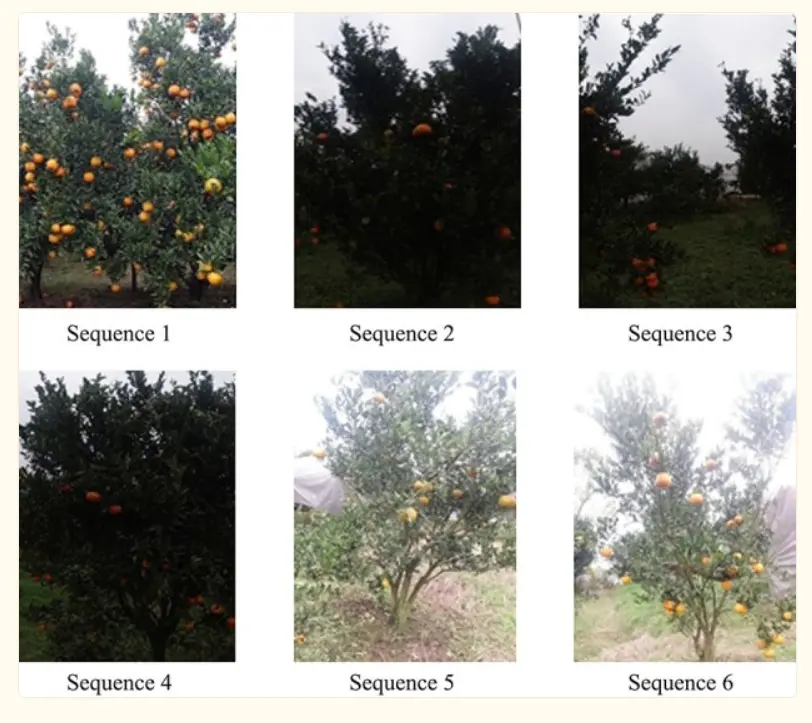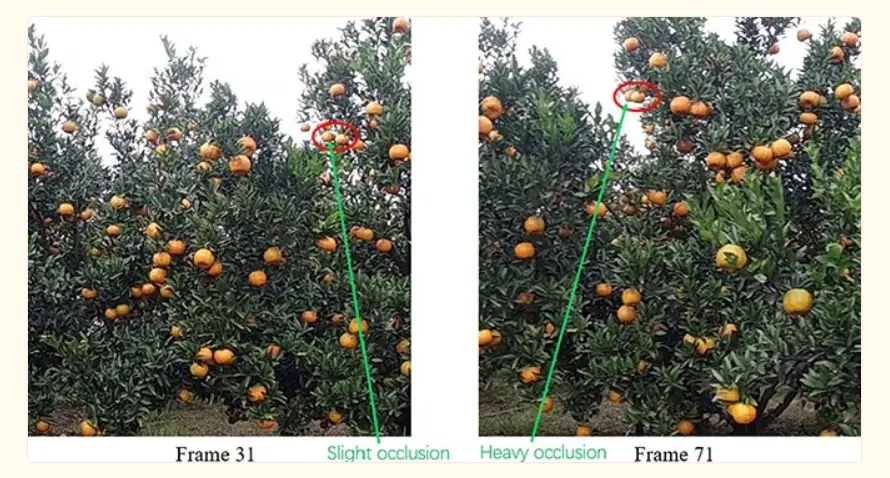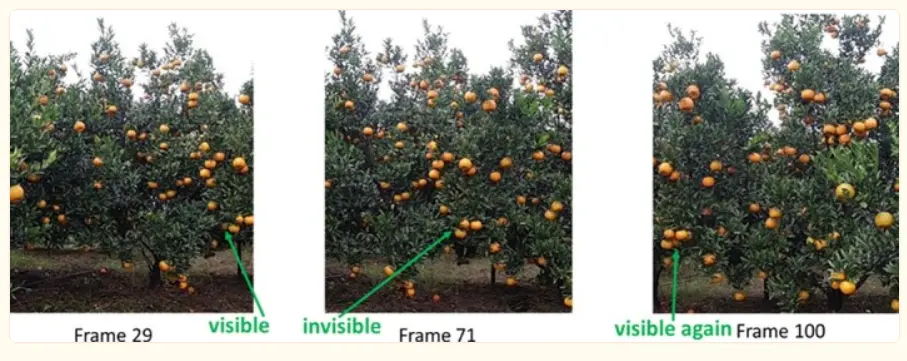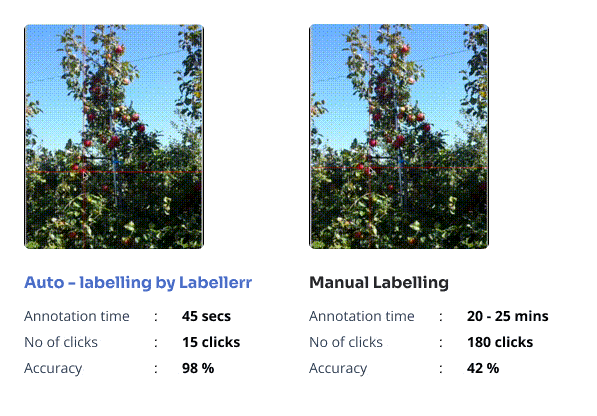Faster Image Labeling For Fruit Detection With Labellerr Using SAM

Table of Contents
- Introduction
- Challenge
- Solution Using Labellerr for Fruit Detection in Trees
- Conclusion
- Frequently Asked Questions
Introduction
In precision agriculture, the ability to accurately detect and quantify fruits on trees has immense potential for revolutionizing farming practices.
By using the power of computer vision, farmers can gain invaluable insights into crop health, yield estimation, and harvesting strategies, ultimately optimizing resource allocation and enhancing productivity.
Fruit detection systems use algorithms to analyze images captured by drones or sensors, enabling farmers to monitor fruit development, assess orchard health, and plan harvesting operations with precision.
However, the reliability and effectiveness of these systems heavily rely on the availability of meticulously annotated datasets.
By facilitating the creation of accurately labeled datasets, Labellerr allows farmers and agricultural researchers to train robust detection models capable of providing actionable insights for optimizing fruit production and management.
Challenge
Automated fruit detection in field is an important technique for modern agriculture, enabling improvements in yield estimation and harvesting. However, the complexity of the environment makes it difficult to achieve precise and robust detection.
Environmental Factors
Lighting Conditions: Natural lighting changes during the day and can be altered by weather conditions, resulting in uneven image quality.
Shadows and reflections: The shadows created by foliage or other fruits, as well as the reflections from moist surfaces, may hide fruits.
Background Clutter: Leaves, branches, and other plants in the background might make it difficult to spot fruits since they may mix with the environment.
To deal with this challenge annotators can use:
Image normalization approaches involve pre-processing images to modify brightness, contrast, and color balance before putting them into the model. This helps to standardize the appearance of fruits under various lighting circumstances.
Data augmentation with simulated shadows/reflections: Use approaches that duplicate shadows and reflections on fruits to train the model to deal with these variances.

Occlusion
Partial Occlusion: Fruits frequently overlap with leaves, branches, or other fruits, causing partial visibility. This blockage makes it difficult to see the full fruit.
Dense foliage: Fruits can be obscured from the view, making it difficult for cameras and sensors to obtain quality photos.

To remove occlusion annotators can use:
Active Learning: Train models to concentrate on visually important parts of the image, emphasizing locations where fruits are more likely to appear.
Part-based detection: Train models to recognize individual portions of a fruit (e.g., stem, blossom end) even when the entire fruit is obscured because of occlusion.
Movement and instability
Wind and Plant Movement: Blurry images or frame inconsistencies are captured due to constant movement of fruits and foliage by the wind.
Camera and Equipment Movement: Under field conditions, equipment such as drones or handheld devices may move, resulting in unstable image capture.

To reduce the blurriness and improve the image quality annotators can apply:
Motion prediction approaches: Experiment with motion prediction approach to predict the movement of fruits and foliage caused by wind or other factors. This allows the model to focus on important areas of interest even in unsteady video frames.
Object tracking algorithms: Use object tracking techniques to follow the movement of fruits over video frames. This helps the model to stay focused on the fruit of interest even when it moves slightly.
Overcoming these challenges mandates advanced annotation methodologies and tools to streamline the annotation workflow and generate high-quality labeled datasets crucial for training robust fruit detection models in agriculture.
Solution Using Labellerr for Fruit Detection in Trees

To address these challenges, companies and researchers employ annotation platforms like Labellerr to streamline the annotation process.
By harnessing Labellerr's capabilities, they can annotate data with increased speed and accuracy, thereby doubling their release velocity for developing AI-powered image analysis software.
Read the full documentation for using SAM in an annotation workflow with Labellerr.
Below we discuss multiple factors by which Labellerr helps teams to overcome challenges.
Intuitive Interface
Labellerr boasts an intuitive user interface designed to streamline the annotation process for fruit detection in trees.
With user-friendly navigation tools and clear labeling options, annotators can easily identify and annotate fruits within images.
The intuitive interface minimizes the learning curve, allowing annotators to focus on the task at hand without being hindered by complex annotation tools.
Cost Savings
Labellerr offers significant cost savings for fruit detection projects by optimizing the annotation process and reducing manual labor costs.
Its advanced automation features automate repetitive tasks, such as image uploading and annotation management, minimizing the need for extensive human intervention.
By streamlining the workflow, Labellerr enables efficient annotation of large datasets, ultimately saving time and resources for agricultural organizations.
Robust Segmentation Features
Labellerr incorporates robust segmentation features, including the Segment Anything Model (SAM), specifically tailored for fruit detection tasks.
SAM's advanced algorithms excel at accurately delineating fruits within images, regardless of variations in shape, size, or occlusions.
By leveraging SAM's segmentation capabilities, Labellerr ensures the precision and reliability of annotated datasets, essential for training robust fruit detection models.
Custom Workflows
Labellerr supports customizable workflows tailored to the unique requirements of fruit detection projects.
Users can define custom annotation protocols, designate fruit categories, and customize labeling criteria to align with specific project objectives.
This flexibility enables annotators to adapt the annotation process to suit the nuances of different fruit types and environmental conditions, ultimately enhancing the accuracy and effectiveness of fruit detection models.
Active Learning Based Labeling
Labellerr incorporates active learning techniques to optimize the fruit detection process.
By intelligently selecting the most informative samples for annotation, Labellerr maximizes the efficiency of data labeling, reducing manual effort while improving the performance of trained models.
This active learning-based approach enables agricultural professionals to prioritize labeling efforts on data points that are most beneficial for model training, ultimately leading to more accurate and effective fruit detection models.
Automated Import and Export of Data
Labellerr streamlines the process of importing and exporting data for fruit detection tasks with its automated functionalities.
Whether integrating data from drones, sensors, or other sources, Labellerr simplifies the data management process, enabling seamless integration of datasets into the annotation platform.
Similarly, Labellerr facilitates the export of annotated data, ensuring compatibility with various machine learning frameworks for model training and deployment.
Collaborative Annotation Pipeline
Labellerr fosters collaboration among agricultural professionals with its collaborative annotation pipeline.
Multiple users can work simultaneously on annotating images of fruit trees, enabling distributed workflows and real-time collaboration.
This collaborative approach enhances productivity and ensures consistency and accuracy in the labeled dataset, ultimately improving the performance of fruit detection models.
Conclusion
In conclusion, Labellerr emerges as a pivotal tool in advancing fruit detection in trees through its comprehensive annotation solutions.
By addressing the complex challenges associated with annotating agricultural images, Labellerr empowers agricultural professionals to create accurate and reliable datasets essential for training robust fruit detection models.
With features such as active learning-based labeling, automated import and export of data, collaborative annotation pipelines, and automated quality assurance.
Labellerr streamlines the annotation process, enhances productivity, and ensures the consistency and accuracy of labeled datasets.
As a result, Labellerr facilitates the development of precise and effective fruit detection models, ultimately contributing to improved crop management, yield optimization, and resource allocation in agriculture.
Frequently Asked Questions
Q1) What is fruit detection in trees, and why is it important in agriculture?
Fruit detection in trees involves using computer vision technology to analyze images of fruit trees and identify individual fruits.
It is essential in agriculture for monitoring crop health, estimating yields, and optimizing harvesting strategies.
Q2) How does Labellerr assist in annotating images of fruit trees for detection tasks?
Labellerr provides advanced annotation tools and features specifically designed for annotating images of fruit trees.
Its intuitive interface, robust segmentation capabilities, and collaboration features streamline the annotation process, enabling agricultural professionals to annotate images efficiently and accurately for analysis.
References
- Deep-learning-based in-field citrus fruit detection and tracking (Link)

Simplify Your Data Annotation Workflow With Proven Strategies
Download the Free Guide

